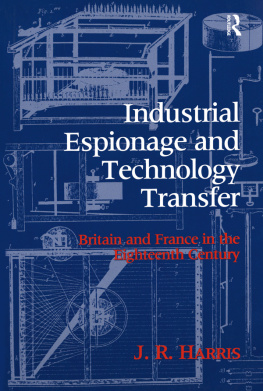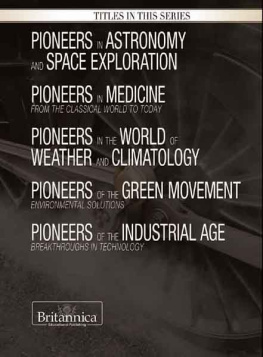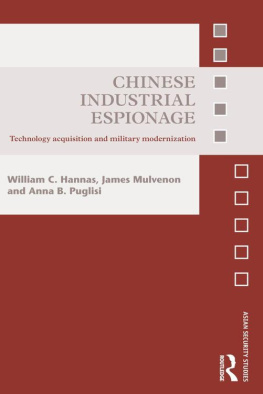First published 1998 by Ashgate Publishing
Published 2017 by Routledge
2 Park Square, Milton Park, Abingdon, Oxon, OX14 4RN
711 Third Avenue, New York, NY 10017, USA
Routledge is an imprint of the Taylor & Francis Group, an informa business
Copyright J. R. Harris, 1998
All rights reserved. No part of this book may be reprinted or reproduced or utilised in any form or by any electronic, mechanical, or other means, now known or hereafter invented, including photocopying and recording, or in any information storage or retrieval system, without permission in writing from the publishers.
Notice:
Product or corporate names may be trademarks or registered trademarks, and are used only for identification and explanation without intent to infringe.
British Library Cataloguing in Publication Data
Harris, John
Industrial Espionage and Technology Transfer: Britain and France in the Eighteenth Century.
1. Business intelligenceGreat BritainHistory18th century. 2. Business intelligenceFranceHistory18th century. 3. Technology transferGreat BritainHistory18th century. 4. Technology transferFranceHistory18th century.
1. Title.
338.926094109033
Library of Congress Cataloging-in-Publication Data
Harris, J. R. (John Raymond)
Industrial espionage and technology transfer: Britain and France in the eighteenth century/J.R. Harris,
p. cm.
Includes bibliographical references and index.
1. Business intelligenceGreat BritainHistory18th century. 2. Business intelligenceFranceHistory18th century. 3. Technology transferGreat BritainHistory18th century. 4. Technology transferFranceHistory18th century. I. Title.
HD38.7.H37 1997
Typeset in Sa bon by Mantn Typesetters, 5-7 Eastfield Road, Louth LN11 7AJ
ISBN 13: 978-0-7546-0367-2 (pbk)
ISBN 13: 978-0-85967-827-8 (hbk)
Source: By courtesy of the National Portrait Gallery, London
Source: Collection de Mezerac, Chateau de Canon, Normandy. By kind permission of M. Alain de Mezerac
Source: Bibliotheque nationale de France, Paris
Source: Christopher Aspin, James Hargreaves and the Spinning Jenny, Helmsmore Local History Society, 1964. By kind permission of Christopher Aspin
Source: Centre Historique des Archives Nationales a Paris, Document F12 678
Source: Roland de la Platiere, Uart du fabricant de velours de coton, Paris, 1780, plate IV
Source: Gabriel Jars, Voyages metallurgiques: ou, recherches et observations sur les mines & forges des fer, la fabrication de Vacier, celle du fer-blanc, & plusieurs mines de charbon de terre, faites depuis Vannee 1757 jusques & compris 1769, en Allemagne, Suede [sic], Norwege [sic], Angleterre & Ecosse, chez Gabriel Ragnault, Lyon, 1774, plate VII
Source: Ironbridge Gorge Museum Trust
Source: Conservatoire National des Arts et Metiers, Paris, 13571/565.4
Source: Conservatoire National des Arts et Metiers, Paris, 13571/565.6/Dephti Ouest
Source: J.-F.-C. Morand, Uart dexploiter les mines de charbon de terre, ? 176 879
Source: reproduced by permission of Birmingham City Archives, Boulton &c Watt Portfolio 1070
Source: reproduced by permission of Birmingham City Archives, Boulton & Watt Portfolio 694
Source: Archives, ecomusee de la communaute Le Creusot-Monceau
Source: Pilkington Brothers Limited, St Helens, Lancashire
Source: archives of the Compagnie de Saint Gobain; see also M. Hamon, Au coeur du XVIIIe siecle industriel: condition ouvriere et tradition villageoise Saint Gobain, editions PAU, Paris, 1993, between pp. 414 and 415
Source: Pilkington Glass Museum, St Helens, Lancashire
Source: Pilkington Glass Museum, St Helens, Lancashire
Source: archives of the Compagnie de Saint Gobain; see also J. R. Harris and C. Pris, The Memoirs of Delaunay Deslandes, Technology and Culture, vol. 17, no. 2, 1976, p. 215
Source: Conservatoire National des Arts et Metiers, Paris, 13571/172.1112
Source: Conservatoire National des Arts et Metiers, Paris, 13571/170
Source: Conservatoire National des Arts et Metiers, Paris, 13571/219.1
Source: Conservatoire National des Arts et Metiers, Paris, 13571/294.1
Source: Conservatoire National des Arts et Metiers, Paris, 13571/294.4
Over the years in which I have gathered materials and explored ideas for this book I have received generous help from many people, so many that it is impossible to record every instance. Franois Crouzet and Franois Caron, whose advice and encouragement gave this study its first impetus, have given splendid academic support over the years, and their friendship and hospitality (and that of Franoise Crouzet and Marie-Thrse Caron) have been treasured. My morale has been supported by two celebrated American historians of technology, Eugene Ferguson and Edwin Layton, who have had a complete understanding of what I was trying to do, and continually urged me to persevere. I had become familiar with the work of John Nef in the early 1940s, but it was a deep pleasure to make his acquaintance in his later years, and to talk and correspond about issues of industrial history on which his interest never dimmed. Nearly twenty years ago, I learned that Harold T. Parker was examining the work of the French eighteenth-century Bureau of Commerce, an institution of central interest to me, and discovered that his study was at least as concerned with the abilities and characters of its public servants as with the mechanics of the institution. A very happy and profitable cooperation has resulted. Nearer home, Peter Jones has fielded with tact and clarity my endless questions about the general historical background of eighteenth-century France.
As I have never pretended to expertise on textile history, I have been particularly grateful for the help I have received in this field; Serge Chassagne has read and commented on some sections of the book from his authoritative expertise on the history of the French cotton industry, Douglas Farnie and Christopher Aspin have similarly commented on my efforts to understand the English side of the process of technological transfer in textiles I can only hope that I have profited sufficiently from their help. In another instance I have been again fortunate in my friends; Alan Smith, John Allen and Jim Andrew have been kind enough to read my chapter on the steam engine in draft. Recent years have seen a friendly exchange of materials and ideas with Dan Christensen which looks set to continue to our mutual profit, as we continue to examine the activities of Scandinavian industrial spies, while the discovery that Margaret Bradley was pursuing the same French ones that I was has been a source not only of new knowledge but of cheerful encouragement.








